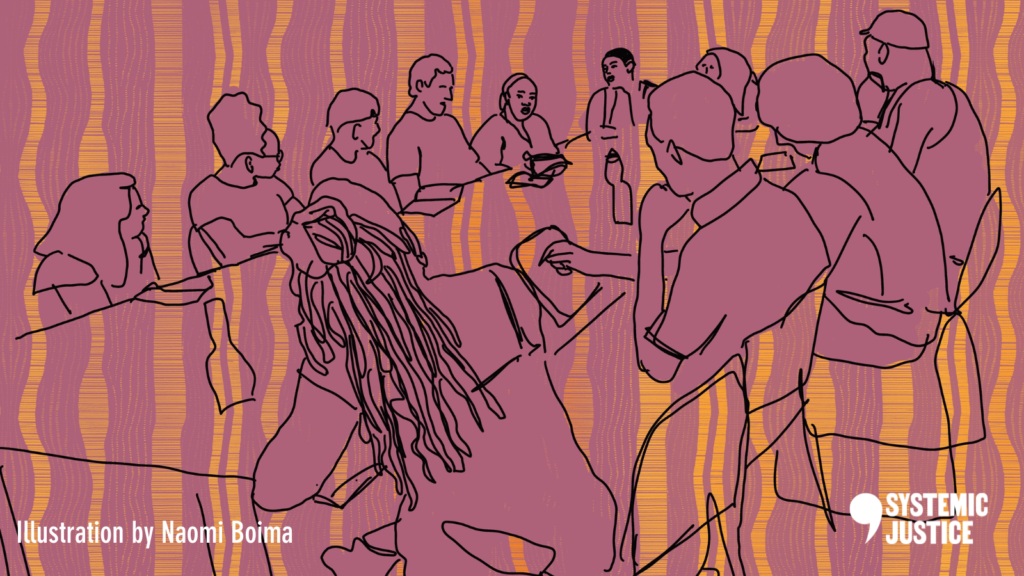We are thrilled to welcome Gracie Bradley, Stephanie Brobbey, and Cristina Guerrero Paez as the inaugural members of Systemic Justice’s Supervisory Board. Not only are we excited about the subject-matter expertise and knowledge on governance, organisational development, and finance they bring, our new Supervisory Board also constitutes an important milestone in our development from a startup to a more mature organisation.

Why does Systemic Justice’s governance matter?
Systemic Justice is registered as a non-profit organisation in the Netherlands. The incorporation form we operate under is called a stichting, which translates as “foundation” and equates more or less to what would be a Charity in the UK or a gGmbH in for example Germany. The stichting is a common form for charitable organisations to work under, due to the relative ease with which you can set up a solid system of checks and balances (or: “good governance”) and register the organisation at the Chamber of Commerce. We are recognised as an Algemeen Nut Beogende Instelling – ANBI (Public Benefit Organisation) by the Dutch tax authority, which means that our mission and activities are recognised as serving the public good.
There are many reasons that movements, collectives, and activists operating in other contexts may have to not formally set up as an organisation, charitable or otherwise. As our core work consists of working with our community partners on court cases, having a formal, regulated structure that is underpinned by formal statutes is important and adds the necessary security and oversight for us to be a reliable partner not only in practice, but in an institutional sense as well.

Why are we excited about a change in our governance structure?
Most non-profit entities in Europe that are comparable to a stichting only offer one type of governance structure: a Board. This can be called a Management Board, a Board of Directors or something else, but comes down to the same principle: a group of people is entrusted with being the “owners” of the organisation and taking responsibility for its compliance and pursuit of its statutory mission. Sometimes, an Executive Director is part of that Board and mandated with a power of attorney to handle the non-profit’s “daily business”. Sometimes, the Board actually runs the day-to-day of the organisation. And sometimes, the Board appoints a management team to do this.
There are many options. In practice, however, as an organisation matures and the day-to-day is handled by an Executive Director or management team, Board members increasingly move to a position of oversight rather than doing anything hands on. Reporting structures tend to reflect this, with the Executive Director or management team reporting to the Board on a regular basis and requesting approval for anything they want to do.
The Dutch system is special in that it allows to formalise this oversight function. To do so, you can establish a Supervisory Board, which sits “above” the regular Board level. By doing so, you can create a clearer separation of functions (daily running of the organisation v. oversight), which in turn supports building a stronger organisation by putting in place clearer checks and balances. Now that Systemic Justice is fully operational and has its necessary systems in place and functioning, its daily management can safely be left to its Director, with a Supervisory Board overseeing the management of the organisation.

What does a Supervisory Board do? Is it like an Advisory Board or a group of patrons?
The regulatory task of the Supervisory Board is to supervise the management by the Board and the general course of business in the organisation. This includes:
- Holding the Board accountable and appointing, evaluating, and firing members of the Board;
- Ensuring the organisation’s strategy is in line with its statutes;
- Overseeing the financial health of the organisation, including approval of the annual accounts, as well as the organisation’s risk management.
A good Supervisory Board will also act as a “critical friend” to the Board, and support their work and the organisation with requested and unrequested advice.
In short, the Supervisory Board has a formal responsibility to ensure the stichting pursues its statutory mission in a way that is compliant with regulatory frameworks. It therefore is very different in nature from voluntary structures like an Advisory Board, Group of Friends, patrons, or other types of affiliations to a non-profit that do not come with regulated governance duties.
Will we keep this structure from now?
Assuming Systemic Justice will continue its current development path, it is unlikely we’ll revert to a one-tier structure anytime soon. This, however, does not mean that the current setup is completely static.
One of the key responsibilities of the Operations function within an organisation is continually assessing if the systems and structures we have in place are the best fit with our needs and our ability to pursue our mission. As our work grows and scales, it could be that the two-tier structure will change in composition.
We are also in the process of exploring how, in addition to the formal oversight by the Supervisory Board, we can best create an accountability structure for the wider ecosystem in which we operate. How can we make sure communities, who are driving our work both when it comes to the thematic issues we work on and the litigation projects that concern them, can also hold us to account in how we do this work?
These are exciting questions that we look forward to continuing exploring over the coming period. As always, we welcome your thoughts and reflections, and: we will keep you posted on our progress!
